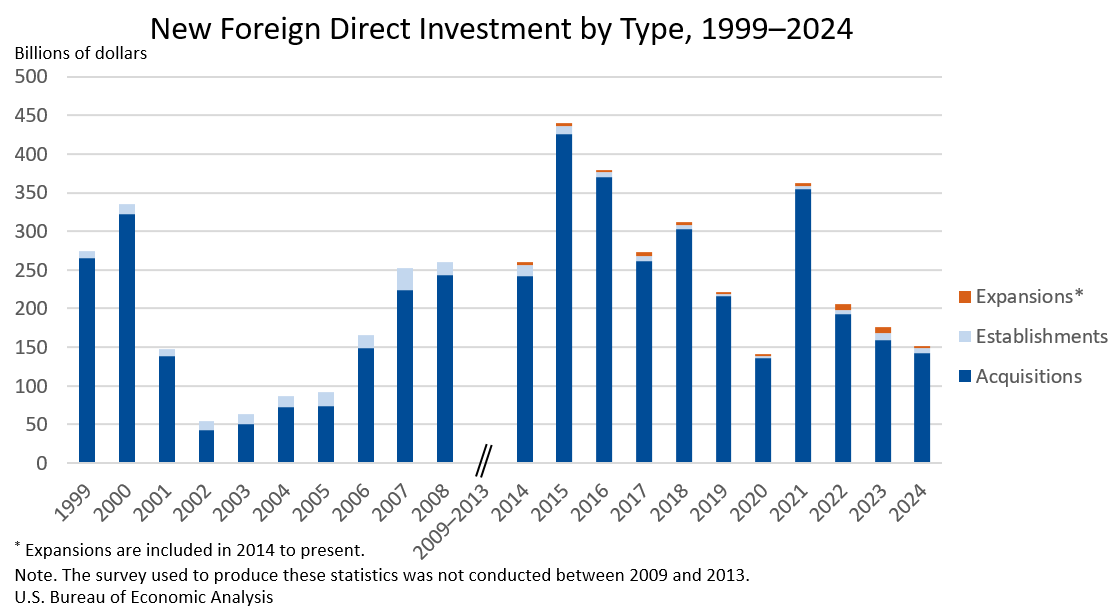Bureau of Economic Analysis
New Foreign Direct Investment in the United States, 2024
Expenditures by foreign direct investors to acquire, establish, or expand U.S. businesses totaled $151.0 billion in 2024, according to preliminary statistics released today by the U.S. Bureau of Economic Analysis. Expenditures decreased $24.9 billion, or 14.2 percent, from $176.0 billion (revised) in 2023 and were below the annual average of $277.2 billion for 2014–2023. As in previous years, acquisitions of existing U.S. businesses accounted for most of the expenditures.
Principal Federal Economic Indicators
Noteworthy
- 2025 News Release Schedule
- Innovation at BEA
- 2025 Annual Updates
- New! Services Trade Data for More Countries
- Data Tool: Trade in Value Added
- Distribution of State Personal Income
- Updated: RIMS II Regional Multipliers
- Arts and Culture
- Space Economy
- FDI Now in State BEARFACTS
- Quick Guide: Price Indexes
The Latest
State Personal Income: Third Quarter 2009 [12/17/09]
State personal income growth averaged 0.3 percent in the third quarter of 2009 with 19 states seeing net earnings growth for the first time in at least a year, according to estimates released today by the U.S. Bureau of Economic Analysis. Personal income growth rates ranged from 0.9 percent in Alaska to -0.4 percent in Louisiana.
Gross Domestic Product, 3rd quarter 2009 (third estimate); Corporate Profits, 3rd quarter 2009 (revised estimate)
GROSS DOMESTIC PRODUCT: THIRD QUARTER 2009 (THIRD ESTIMATE) CORPORATE PROFITS: THIRD QUARTER 2009 (REVISED ESTIMATE) Real gross domestic product -- the output of goods and services produced by labor and property located in the United States -- increased at an annual rate of 2.2 percent in the third quarter of 2009, (that is, from the second quarter to the third quarter), according to the "…
County Estimates of Compensation by Industry, 2006-2008
Compensation grew in over 80 percent of the 3,112 counties in the U.S., as the average annual compensation per job in the U.S. grew by 2.6 percent to $56,116, according to statistics released today by the U.S. Bureau of Economic Analysis (BEA). Total compensation of U.S. workers grew 2.3 percent in 2008, as net job losses partially offset compensation growth. Inflation measured by the national price index for personal consumption…
U.S. International Transactions: Third Quarter 2009
NOTE: See the navigation bar at the right side of the news release text for links to data tables, contact personnel and their telephone numbers, and supplementary materials. -->
Travel and Tourism Satellite Accounts, 3rd Quarter 2009
QUARTERLY TOURISM ESTIMATES WILL NOT BE DISCONTINUED (SEE THE BOX NEXT RELEASE)
-->
-->
U.S. International Trade in Goods and Services, October 2009
U.S. International Trade in Goods and Services DECEMBER 2007
-->
Personal Income and Outlays, October 2009
Personal income increased $30.1 billion, or 0.2 percent, and disposable personal income (DPI) increased $45.7 billion, or 0.4 percent, inOctober, according to the Bureau of Economic Analysis. Personal consumption expenditures (PCE) increased $68.3 billion, or 0.7 percent.
Gross Domestic Product, 3rd quarter 2009 (second estimate); Corporate Profits, 3rd quarter 2009 (preliminary estimate)
GROSS DOMESTIC PRODUCT: THIRD QUARTER 2009 (SECOND ESTIMATE) CORPORATE PROFITS: THIRD QUARTER 2009 (PRELIMINARY) Real gross domestic product -- the output of goods and services produced by labor and property located in the United States -- increased at an annual rate of 2.8 percent in the third quarter of 2009, (that is, from the second quarter to the third quarter), according to the "…
U.S. International Trade in Goods and Services, September 2009
U.S. International Trade in Goods and Services DECEMBER 2007
-->
Personal Income and Outlays, September 2009
Personal income decreased $0.1 billion, or less than 0.1 percent, and disposable personal income (DPI) decreased $0.2 billion, or less than 0.1 percent, inSeptember, according to the Bureau of Economic Analysis. Personal consumption expenditures (PCE) decreased $47.2 billion, or 0.5 percent.




